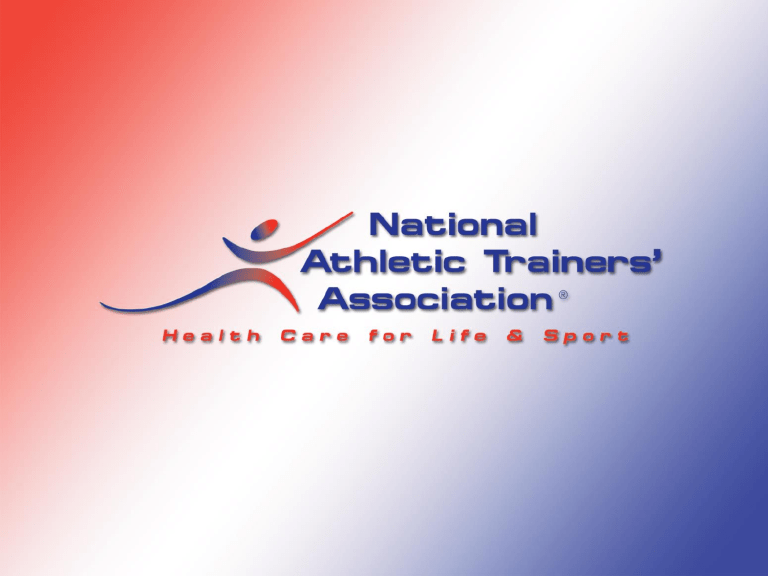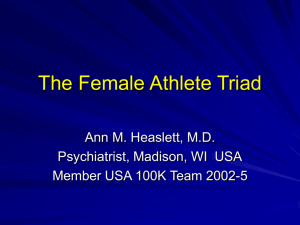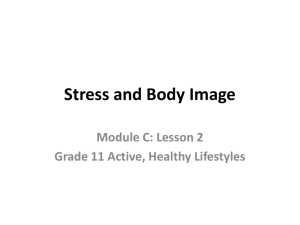The Female Athlete Triad - National Athletic Trainers

The Female Athlete Triad
Taken from:
Managing the Female Athlete Triad. NCAA Coaches Handbook
National Athletic Trainers’ Associated Position Statement: Preventing
Detecting, and managing Disordered Eating in Athletes. Journal of
Athletic Training; 2008. 43(1):80-108
Female Athlete Triad
• Disordered Eating
• Includes the full spectrum of abnormal eating behaviors, ranging from simple dieting to clinical eating disorders.
• Amenorrhea
• The loss of menstruation
• Primary-the individual has not experienced her first menstrual period by age 15 when secondary sex characteristics have developed
• Secondary-the postmenarchal athlete misses three consecutive periods.
• Osteoporosis
• Disease characterized by low bone mass and deterioration of bones tissue, resulting in bone fragility and increased risk of fracture.
Disordered Eating
• The term “disordered eating” is used rather than eating disorders because the athlete's eating does not have to be disordered to the point of a clinical eating disorder in order for the other two components of the athlete triad to occur.
• Disordered Eating can be inadvertent such as mistakenly eating too little to fuel the body.
• Willfully restricting caloric intake (dieting, dietary restriction) is the primary precursor to eating disorders.
Coaches Role in Recognizing
Disordered Eating
• Coaches are in a good position to identify disordered eating.
• Identification can by complicated by sport body stereotypes.
• Lean body types=increased performance & good performance=good health.
• Coaches need to be aware of physical/medical and psychological/behavioral signs and symptoms of disordered eating.
Signs and Symptoms of Disordered Eating
Physical/Medical Signs and
Symptoms
Psychological/Behavioral
Signs and Symptoms
• Amenorrhea
• Dehydration
• Gastrointestinal Problems
• Hypothermia
• Stress Fractures (overuse injuries)
• Significant Weight Loss
• Muscle Cramps,
Weakness, or Fatigue
• Dental and Gum
Problems
• Anxiety and/or Depression
• Claims of “Feeling Fat”
Despite Being Thin
• Excessive Exercise
• Excessive Use of Restroom
• Unfocused, Difficultly
Concentrating
• Preoccupation with Weight and Eating
• Avoidance of Eating and
Eating Situations
• Use of Laxatives, Diet Pills, etc.
Amenorrhea
• Amenorrhea is very common among female athletes.
• Some female athletes even see it as the “norm” for sports among their peers; this makes it very difficult to catch because of lack of reporting.
• It does not have to fall on the coach to monitor for this condition, rather, it should fall into the hand of a team physician, nurse, or athletic trainer.
What to do?
• A designated health-care professional should meet with the team prior to each season to inform the student-athletes about the importance of healthy menstrual function.
• Make it clear how and to whom they should report any irregularities.
Amenorrhea
• Amenorrhea related to sport participation can often be reversed.
• Common treatments include:
• Increased caloric intake
• Decrease in physical activity
• Rare cases could require hormone therapy
• An athlete’s response to recommendations regarding eating, training, and medication will vary. Difficulty in compliance usually increases with the severity of the disordered eating.
Osteoporosis
• Unfortunately, bone problems are typically the first signs reported within the triad.
• If frequent fractures, especially stress fractures, are present, the student-athlete should also be assessed for menstrual dysfunction and disordered eating.
• The treatment of osteoporosis and amenorrhea is key because it involves the athlete's current and future reproductive and bone health.
Prevention Strategies
1. De-emphasize weight
• Emphasis on weight or thinness/leanness will likely increase the risk of disordered eating.
• De-emphasis will likely have the converse effect.
2. Recognize individual differences in athletes
• By focusing on the athlete's individual differences, the likelihood of enhanced performance for each athlete can be increased
3. Education
• Education should be made available to everyone involved
• Coaches remain instrumental in the detection of the triad, therefore education is key.
4. Involvement by Sport Governing Bodies







